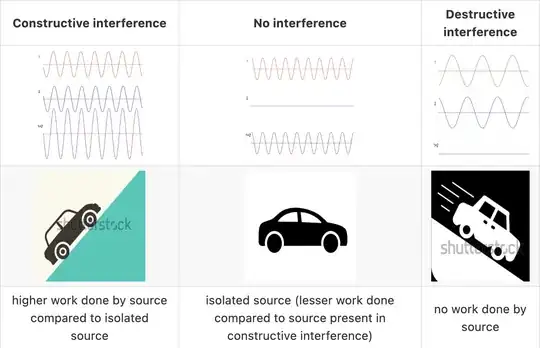The energy does not double. This is prevented in part by the Born rule. Consider the state vector $|\psi\rangle~=~\sum_n c_n|n\rangle$, where it is easy to see $c_n~=~\langle\psi|n\rangle$. The energy eigenvalues are computed as $H|n\rangle~=~E_n|n\rangle$. For the single wave function the amplitudes are found by the modulus square $\langle\psi|\psi\rangle~=~1$ of the wave, where
$$
\langle\psi|\psi\rangle~=~\sum_nc_n^*c_n~=~\sum_nP_n~=~1
$$
Now consider the expectation of the Hamiltonian
$$
\langle\psi|H|\psi\rangle~=~\sum_nP_nE_n.
$$
To address this question directly we then consider the sum of two waves in a superposition with the state vectors $|\psi_1\rangle$ and $|\psi_2\rangle$,
$$
|\psi_1\rangle~=~\sum_n c_{n,1}|n\rangle,~|\psi_2\rangle~=~\sum_n c_{n,2}|n\rangle,
$$
where the two waves are expanded in their own coefficients which are normalized for the sum of the two waves. Consider the modulus square of the sum $|\psi_t\rangle~=~|\psi_1\rangle~+~|\psi_2\rangle$ of the two waves
$$
\langle\psi_t|\psi_t\rangle~=~\sum_n(c_{n,1}^*c_{n,1}~+~ c_{n,2}^*c_{n,2}~+~ c_{n,1}^*c_{n,2}~+~ c_{n,2}^*c_{n,1})
$$
At this point you can now see the answer to the question. The amplitude coefficients $c_{n,1}$ and $c_{n,2}$ are normalized to counter the growth by four of the modulus square of the amplitudes. This is particularly easy to see if $c_{n,1}~=~c_{n,2}$, where now the amplitudes for the two waves are normalized to $1/\sqrt{2}$ their independent values. One might have $c_{n,1}~=~exp(ikx_1)c_n$ and $c_{n,2}~=~exp(ikx_2)c_n$, where the interference term
$$
c_{n,1}^*c_{n,2}~+~ c_{n,2}^*c_{n,1}~=~c_n(e^{ik(x_1~-~x_2)}~+~ e^{ik(x_2~-~x_1)})
$$
which gives an oscillating term with respect to the difference $ x_1~-~x_2$. Then further the expectation of the Hamiltonian $\langle\psi_t|H|\psi_t\rangle$ is similarly expanded as
$$
\langle\psi_t|\psi_t\rangle~=~\sum_n(c_{n,1}^*c_{n,1}~+~ c_{n,2}^*c_{n,2}~+~ c_{n,1}^*c_{n,2}~+~ c_{n,2}^*c_{n,1})E_n
$$
where there is clearly no increase in the energy.
 we see in the image at left a constructive pattern and at right a destructive pattern. This game to 'shape the field' in space is played with antenna arrays always. What means the obvious diference in the intensities? Physically one radiator is moved apart from the other half wavelength, and the feed (current intensity, frequency,phase) of both radiators was kept invariant. It appears that when the field cancels one (strange property) must say to both radiators: Stop radiating! Or as Bykov 'they feel the wave from the other source'. But this is complete nonsence.
we see in the image at left a constructive pattern and at right a destructive pattern. This game to 'shape the field' in space is played with antenna arrays always. What means the obvious diference in the intensities? Physically one radiator is moved apart from the other half wavelength, and the feed (current intensity, frequency,phase) of both radiators was kept invariant. It appears that when the field cancels one (strange property) must say to both radiators: Stop radiating! Or as Bykov 'they feel the wave from the other source'. But this is complete nonsence.

